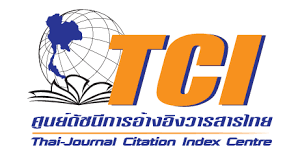THE APPLICATION OF PUBLIC INFORMATION DISCLOSURES FOR PREDICTION OF BANKRUPTCY: EVIDENCE FROM THE STOCK EXCHANGE OF THAILAND
Keywords:
Bankruptcy Prediction, Discriminant Analysis, Logistic Regression AnalysisAbstract
This research aims to the first, study information’s accounting and corporate governance which factors can be used to explain bankruptcy prediction as a tool to help investors and stakeholder making decisions. The second, develop the bankruptcy prediction model and comparation accuracy of model between Discriminant Analysis and Logistic Regression Analysis to identify what is an appropriately model. The total sample of 114 listed firms in the Stock Exchange of Thailand and divided into two groups: namely, financial distress of 31 firms and the non-financial distress of 83 firms. By the same size of assets, industry and period. The results show that factors reveal such as shareholder board, proportion independent committee, proportion audit committee, two consecutive years loss and cash flow per total assets ratio determined as the bankruptcy predictions. In additional, the bankruptcy prediction model via Logistic Regression Analysis provides the most accuracy percentage of 78.10 which is accuracy prediction higher than Discriminant Analysis accuracy percentage of 76.30.
References
จินดา ขันทอง. 2541. Red Flags on Financial Failure: The Case of Thai Corporations. วิทยานิพนธ์ระดับปริญญาเอก, จุฬาลงกรณ์มหาวิทยาลัย. กรุงเทพฯ
นันทนัช ธิติสุทธิ. 2556. แบบจำลองการพยากรณ์ความล้มเหลวทางการเงินโดยใช้ Logit Model. การศึกษาค้นคว้าอิสระบัญชีมหาบัณฑิต สาขาบัญชี, มหาวิทยาลัยธรรมศาสตร์. กรุงเทพฯ.
ปานรดา พิลาศรี. 2554. แบบจำลองภาวะความล้มเหลวทางการเงินของบริษัทจดทะเบียนในตลาดหลักทรัพย์แห่งประเทศไทย. การศึกษาค้นคว้าอิสระบัญชีมหาบัณฑิต สาขาบัญชี, มหาวิทยาลัยธรรมศาสตร์. กรุงเทพฯ.
ภรณ์ทิพย์ ชูรอด. 2557. การพยากรณ์ความล้มเหลวทางการเงินของบริษัทจดทะเบียนในตลาดหลักทรัพย์แห่งประเทศไทย. (วิทยานิพนธ์บัญชีมหาบัณฑิต สาขาบัญชี, มหาวิทยาลัยเกษตรศาสตร์).
รวิษฎา สุขแสวง และดารณี เอื้อชนะจิต. 2560. อัตราส่วนทางการเงินที่ทำนายภาวะความล้มเหลวทางธุรกิจของบริษัทที่จดทะเบียนในตลาดหลักทรัพย์แห่งประเทศไทย. (วิทยานิพนธ์ปริญญามหาบัณฑิต, มหาวิทยาลัยธุรกิจบัณฑิตย์).
วิชชกานต์ เมธาวิริยะกุล, ปานฉัตร อาการักษ์ และวัฒนา ยืนยง. (2560). ตัวแบบสัญญาณเตือนภัยล่วงหน้าทางการเงิน: การเปรียบเทียบระหว่างวิธีการถดถอยโลจิสติคและโครงข่ายประสาทเทียมของบริษัทจดทะเบียนในตลาดหลักทรัพย์แห่งประเทศไทย. วารสารวิชาชีพบัญชี, 13(39). 36-57.
Ahamand, H. M. and Adhariani. (2017). Corporate governance determinants for the mitigation of the likelihood of financial distress. Advances in Economics, Business and Management Research, 36, 1-11.
Altman, E. I. (1968). Financial ratio, discriminate analysis and prediction of corporate Bankruptcy. The Journal of Finance, 23(4), 589-609.
Altman, E. I. (1983). Corporate distress, New York: John Wiley.
Bhandari, B. S. (2014). Two discriminant analysis models of predicting business failure: A contrast of the most recent with the first model. American Journal of Management, 14(3). 11-19.
Darrat, A. F., Gray, S., Park, J. C., & Wu, Y. (2016). Corporate governance and bankruptcy risk. Journal of Accounting, Auditing & Finance, 31(2), 163-202.
Deakin, E. B. (1972). A Discriminant analysis of predictors of business failure. Journal of Accounting Research, 10(1), 167-179.
Elisabete S. VI., Carlos P. and Carla C. (2013). Insolvency prediction in the Portuguese construction industry. Marmara Journal of European studies, 21(2), 143-164.
Hair, Joseph F. and others. (2010). Multivariate data analysis: 7th ed. New Jersey: Pearson Prentice Hall.
Hanani, R. T. and Dharmastuti, C. F. (2015). How do corporate governance mechanisms affect a firm’s potential for bankruptcy. Risk Governance & Control: Financial Markets & Institutions, 5(1), 61-70.
Hertz, J., Krogh, A., and Palmer, R., (1991). Introduction to the theory of neural computing computation. New York: Addsion Wesley.
Jonh, A. T., and Ogechukwu, O L. (2018). Corporate governance and financial distress in the banking industry: Nigerian experience. Journal of Economics and Behavioral Studies 10(1), 182-193.
Khunthong, J. (1997). Red flogs on financial failures: The case of Thai corporations. doctoral dissertation in accounting. National Institute of Development Administration, Bangkok.
Ohlson, James A. (1980). Financial ratios and the probabilistic prediction of bankruptcy. Journal of Accounting Research, 18(1), 109-131.
Polsiri, P. and Sookhanaphibarn, K. (2009). Corporate distress prediction models using governance and financial variables: Evidence from Thai listed firms during the East Asian economic crisis. Journal of Economics and Management, 5(2), 273-304.
Pretorius, M. (2009). Defining business decline, failure and turnaround: a content analysis. The Southern African Journal of Entrepreneurship and Small Business Management, 2(1), 116-128.
Salloum, C. and Azoury, N. (2012). Corporate governance and firms in financial distress: evidence from a middle eastern country. International Journal of Business Governance and Ethics, 7(1), 1-17.
Shyam B. B. (2014). Two discriminant analysis models of predicting business failure: A contrast of the most recent with the first model. American Journal of Management, 14(3), 11-19.
Smith, M., Ren, Y. and Dong, Y. (2011). The predictive ability of “Conservatism” and “Governance” variables in corporate financial disclosures. Asian Review of Accounting, 19(2), 171-185.
Viera, S. E., Pinho, C. and Correia, C. (2013). Insolvency prediction in the Portuguese construction industry. Marmara Journal of European Studies, 21(3), 143-165.
Xavier B. (2014). Bankruptcy prediction model using neural networks. Accounting and Finance Research, 2(3), 124-128.
Zmijewski, M. E. (1984). Methodological issues related to the estimation of financial distress prediction models, Journal of Accounting Research, 22(3), 59-82.






